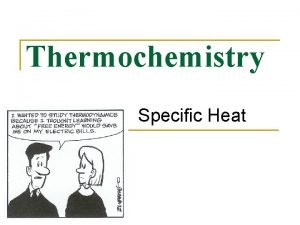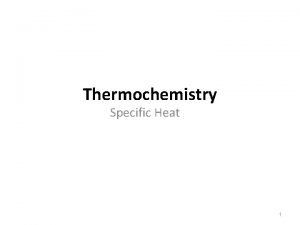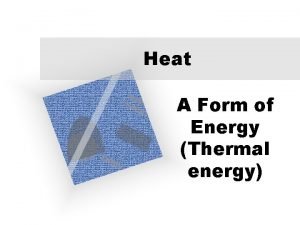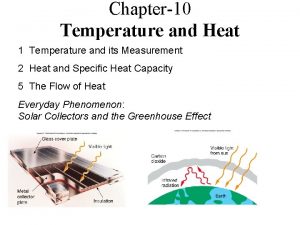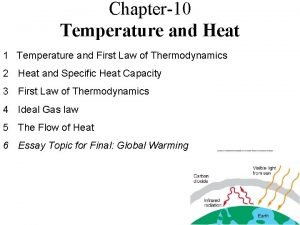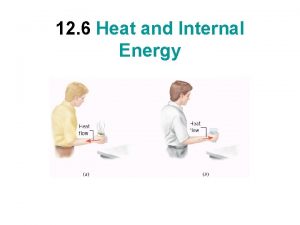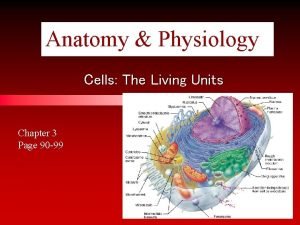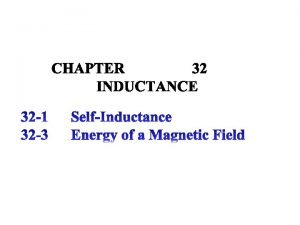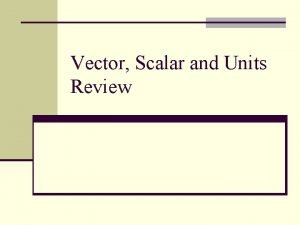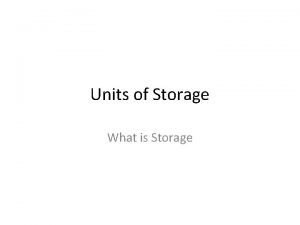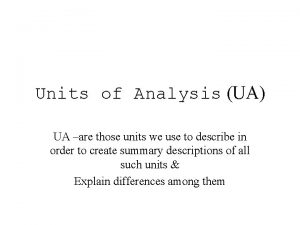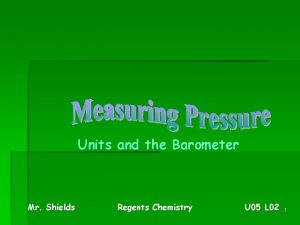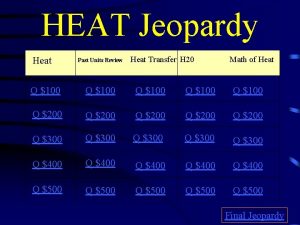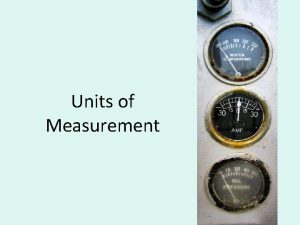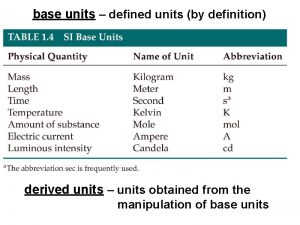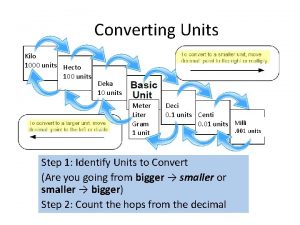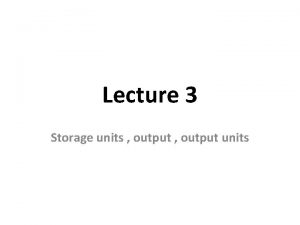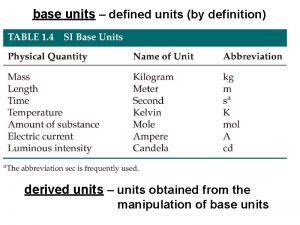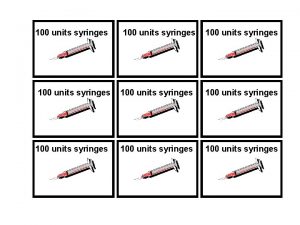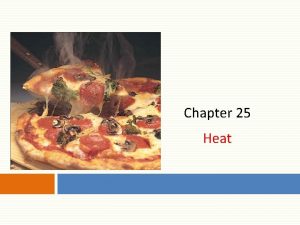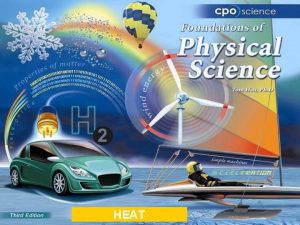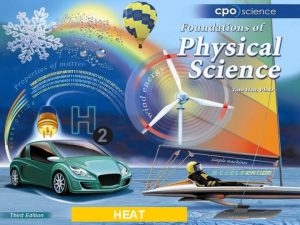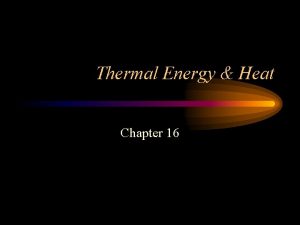Chapter 14 Heat Units of Chapter 14 Heat
































- Slides: 32

Chapter 14 Heat

Units of Chapter 14 • Heat As Energy Transfer • Internal Energy • Specific Heat • Calorimetry – Solving Problems • Latent Heat • Heat Transfer: Conduction • Heat Transfer: Convection • Heat Transfer: Radiation

14 -1 Heat As Energy Transfer We often speak of heat as though it were a material that flows from one object to another; it is not. Rather, it is a form of energy. Unit of heat: calorie (cal) 1 cal is the amount of heat necessary to raise the temperature of 1 g of water by 1 Celsius degree. Don’t be fooled – the calories on our food labels are really kilocalories (kcal or Calories), the heat necessary to raise 1 kg of water by 1 Celsius degree.

14 -1 Heat As Energy Transfer If heat is a form of energy, it ought to be possible to equate it to other forms. The experiment below found the mechanical equivalent of heat by using the falling weight to heat the water:

14 -1 Heat As Energy Transfer Definition of heat: Heat is energy transferred from one object to another because of a difference in temperature. • Remember that the temperature of a gas is a measure of the kinetic energy of its molecules.

14 -2 Internal Energy The sum total of all the energy of all the molecules in a substance is its internal (or thermal) energy. Temperature: measures molecules’ average kinetic energy Internal energy: total energy of all molecules Heat: transfer of energy due to difference in temperature

14 -2 Internal Energy Internal energy of an ideal (atomic) gas: But since we know the average kinetic energy in terms of the temperature, we can write: (14 -1)

14 -2 Internal Energy If the gas is molecular rather than atomic, rotational and vibrational kinetic energy needs to be taken into account as well.

14 -3 Specific Heat The amount of heat required to change the temperature of a material is proportional to the mass and to the temperature change: (14 -2) The specific heat, c, is characteristic of the material. Some values are listed at left.

14 -3 Specific Heat Specific heats of gases are more complicated, and are generally measured at constant pressure (c. P) or constant volume (c. V). Some sample values:

14 -4 Calorimetry – Solving Problems Closed system: no mass enters or leaves, but energy may be exchanged Open system: mass may transfer as well Isolated system: closed system where no energy in any form is transferred For an isolated system, Energy out of one part = energy into another part Or: heat lost = heat gained

14 -4 Calorimetry – Solving Problems The instrument to the left is a calorimeter, which makes quantitative measurements of heat exchange. A sample is heated to a well-measured high temperature, plunged into the water, and the equilibrium temperature measured. This gives the specific heat of the sample.

14 -4 Calorimetry – Solving Problems Another type of calorimeter is called a bomb calorimeter; it measures thermal energy released when a substance burns. This is the way the Caloric content of foods is measured.

14 -5 Latent Heat Energy is required for a material to change phase, even though its temperature is not changing.

14 -5 Latent Heat of fusion, LF: heat required to change 1. 0 kg of material from solid to liquid Heat of vaporization, LV: heat required to change 1. 0 kg of material from liquid to vapor

14 -5 Latent Heat The total heat required for a phase change depends on the total mass and the latent heat: (14 -3) Problem Solving: Calorimetry 1. Is the system isolated? Are all significant sources of energy transfer known or calculable? 2. Apply conservation of energy. 3. If no phase changes occur, the heat transferred will depend on the mass, specific heat, and temperature change.

14 -5 Latent Heat 4. If there are, or may be, phase changes, terms that depend on the mass and the latent heat may also be present. Determine or estimate what phase the final system will be in. 5. Make sure that each term is in the right place and that all the temperature changes are positive. 6. There is only one final temperature when the system reaches equilibrium. 7. Solve.

14 -5 Latent Heat The latent heat of vaporization is relevant for evaporation as well as boiling. The heat of vaporization of water rises slightly as the temperature decreases. On a molecular level, the heat added during a change of state does not go to increasing the kinetic energy of individual molecules, but rather to break the close bonds between them so the next phase can occur.

14 -6 Heat Transfer: Conduction Heat conduction can be visualized as occurring through molecular collisions. The heat flow per unit time is given by: (14 -4)

14 -6 Heat Transfer: Conduction The constant k is called thermal conductivity. Materials with large k are called conductors; those with small k are called insulators.

14 -6 Heat Transfer: Conduction Building materials are measured using R−values rather than thermal conductivity: Here, l is the thickness of the material.

14 -7 Heat Transfer: Convection occurs when heat flows by the mass movement of molecules from one place to another. It may be natural or forced; both these examples are natural convection.

14 -7 Heat Transfer: Convection Many home heating systems are forced hot-air systems; these have a fan that blows the air out of registers, rather than relying completely on natural convection. Our body temperature is regulated by the blood; it runs close to the surface of the skin and transfers heat. Once it reaches the surface of the skin, the heat is released through convection, evaporation, and radiation.

14 -8 Heat Transfer: Radiation The most familiar example of radiation is our own Sun, which radiates at a temperature of almost 6000 K.

14 -8 Heat Transfer: Radiation The energy radiated has been found to be proportional to the fourth power of the temperature: (14 -5) The constant σ is called the Stefan-Boltzmann constant: The emissivity e is a number between zero and one characterizing the surface; black objects have an emissivity near one, while shiny ones have an emissivity near zero.

14 -8 Heat Transfer: Radiation If you are sitting in a place that is too cold, your body radiates more heat than it can produce. You will start shivering and your metabolic rate will increase unless you put on warmer clothing.

14 -8 Heat Transfer: Radiation If you are in the sunlight, the Sun’s radiation will warm you. In general, you will not be perfectly perpendicular to the Sun’s rays, and will absorb energy at the rate: (14 -6)

14 -8 Heat Transfer: Radiation This cos θ effect is also responsible for the seasons.

14 -8 Heat Transfer: Radiation Thermography – the detailed measurement of radiation from the body – can be used in medical imaging. Warmer areas may be a sign of tumors or infection; cooler areas on the skin may be a sign of poor circulation.

Summary of Chapter 14 • Internal energy U refers to the total energy of all molecules in an object. For an ideal monatomic gas, • Heat is the transfer of energy from one object to another due to a temperature difference. Heat can be measured in joules or in calories. • Specific heat of a substance is the energy required to change the temperature of a fixed amount of matter by 1° C.

Summary of Chapter 14 • In an isolated system, heat gained by one part of the system must be lost by another. • Calorimetry measures heat exchange quantitatively. • Phase changes require energy even though the temperature does not change. • Heat of fusion: amount of energy required to melt 1 kg of material. • Heat of vaporization: amount of energy required to change 1 kg of material from liquid to vapor.

Summary of Chapter 14 • Heat transfer takes place by conduction, convection, and radiation. • In conduction, energy is transferred through the collisions of molecules in the substance. • In convection, bulk quantities of the substance flow to areas of different temperature. • Radiation is the transfer of energy by electromagnetic waves.
 Botox brow lift technique
Botox brow lift technique When units manufactured exceed units sold:
When units manufactured exceed units sold: Heat capacity units
Heat capacity units Heat calculations
Heat calculations Homemade calorimeter
Homemade calorimeter Thermal.energy formula
Thermal.energy formula Heat capacity unit
Heat capacity unit Unit of heat capacity
Unit of heat capacity Specific heat capacity unit
Specific heat capacity unit Heat capacity unit
Heat capacity unit Heat capacity vs specific heat
Heat capacity vs specific heat Latent heat problem
Latent heat problem The three principles of cooking
The three principles of cooking Chapter 1 introduction to the structural units
Chapter 1 introduction to the structural units Chapter 1 introduction to the structural units
Chapter 1 introduction to the structural units Chapter 1 introduction to the structural units
Chapter 1 introduction to the structural units Chapter 3 cells the living units
Chapter 3 cells the living units Chapter 3 cells the living units
Chapter 3 cells the living units Mitosis
Mitosis Lucy calkins writing units
Lucy calkins writing units Units of henry
Units of henry Customary units of measurement
Customary units of measurement Rarefraction
Rarefraction 24 cubic units
24 cubic units Conductivity units
Conductivity units Vector vs scalar quantities
Vector vs scalar quantities Vce physical education units 1 and 2 notes
Vce physical education units 1 and 2 notes Customary units of length
Customary units of length What is the approximate value of a gigabyte
What is the approximate value of a gigabyte Units of analysis
Units of analysis Barometer units
Barometer units Examples of si unit
Examples of si unit Countries that use imperial units
Countries that use imperial units



